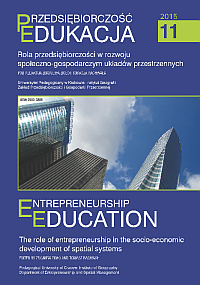Innovative solutions in adapting urban space and tourism development for people with disabilities on the example of selected European cities
DOI:
https://doi.org/10.24917/20833296.11.26Keywords:
accessibility, disability, innovations, sustainable development, tourism, urban spaceAbstract
There are approximately 80 million people with disabilities living in Europe. Most of them live in cities.It is obvious that this group has the ability, aspiration and motivation to travel like normal healthypeople, but on the other hand they also have significantly more barriers in their way, which healthypeople do not have, especially in urban areas. This makes it impossible for handicapped people to befully involved in tourism and everyday life. That is why many European cities face the challenge ofimproving the level of accessibility of their streets, monuments, attractions and buildings, introducingmany innovative approaches and solutions using new technologies and design solutions. They haverecognised the potential of handicapped tourists and introduced a number of improvements, becausemaking urban spaces more accessible both to citizens and visitors will bring benefits in the long-termsustainability of heritage sites. This paper aims to generate relevant knowledge about accessibilityand universal design concepts, with special emphasis on improving the accessibility of historicaltowns and the sustainable development of the available tourism.References
Ambrose, I., Balmas, S., Barragán Iturriaga, A., Medina Higueras, M., Orejas, M. (2013). Accessible Routes in Historical Cities – A best practice guide for the planning, design, implementation and marketing accessible routes in historical urban environments. Bruksela: European Foundation Centre, ASBL.
Darcy, S. (1998). Anxiety to Access: Tourism patterns and experiences of NSW people with physical disabilities. Sydney: Tourism New South Wales.
Darcy, S., Daruwalla, P.S. (1999). The trouble with Travel: People with disabilities and Tourism. Social Alternatives, 18(1), 41-46.
Deichmann, J. (2004). Accessible urban spaces – a challenge for urban designers. Copenhagen: The Fifth International Conference on Walking in the 21st Century, June 9-11 2014.
Donnelly, J. (2003). Universal Human Rights in Theory and Practice. New York: Cornell University Press.
European Commission (2011). European Commission’s proposal to the Gothenburg European Council: A Sustainable Europe for a Better World: A European Union Strategy for Sustainable Development. Brussels: COM.
European Commission (2012). Access – City Award 2012: Rewarding and inspiring accessible cities across the EU. Luxemburg: Publications Office of the European Union.
Mahmoudi, A., Fanaei, K. (2010). Revision of urban spaces to make it accessible for disabled people in order to achieve the aim of “city for all”. W: M. Schrenk, V.V. Popovich, P. Zeile (red.), Cities for everyone – Liveable, Healthy, Prosperous. Vienna: CORP – Competence Center of Urban and Regional Planning, 1217-1222.
Nicolae, I. (2008). Corporate Social Responsibility and Human Rights in the Context of the European Union. The Canadian Centre for German and European Studies, Working Paper Series, 16.
Popiel, M. (2013). Turystyka osób niepełnosprawnych w gospodarce opartej na wiedzy. Prace Komisji Geografii Przemysłu Polskiego Towarzystwa Geograficznego, 23, 119-134.
Rzecznik Praw Obywatelskich (2011). Zasada równego traktowania – prawo i praktyka. Dostępność infrastruktury publicznej dla osób z niepełnosprawnością. Analiza i zalecenia. Warszawa: Biuro Rzecznika Praw Obywatelskich.
United Nations (1993). The Standard Rules on the Equalization of Opportunities for Persons with Disabilities. New York: United Nations.
Wysocki, M. (2009). Dostępna przestrzeń publiczna. Samorząd równych szans. Kraków: Fundacja Instytut Rozwoju Regionalnego.
Downloads
Published
How to Cite
Issue
Section
License
Articles are published under the terms of the Creative Commons License (CC BY-ND 4.0; Attribution– NoDerivs).

